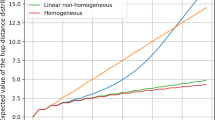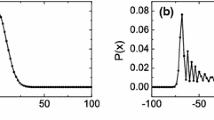Abstract
We describe an algorithm which automates the generation of appropriate shift and coin operators for a discrete time quantum walk, given the adjacency matrix of the graph over which the walk is run. This gives researchers the freedom to numerically investigate any discrete time quantum walk over graphs of a computationally tractable size by greatly reducing the time required to initialise a given walk. We then describe one application in which the swift initialisation of walks has enabled systematic investigations of walks over a large number of structures. New results concerning this application, which is to formal language recognition, are described. The reliability of these results, as well as the general suitability of numerical analysis as a tool for investigating discrete time quantum walks, are briefly discussed. We also mention specific Python packages which facilitate our simulations and analysis, motivating the use of high level programming languages in this context.








Similar content being viewed by others
References
Ambainis A (2004) Quantum walk algorithm for element distinctness. In: Proceedings of the 45th annual IEEE symposium on foundations of computer science. IEEE Computer Society, Washington, DC, pp 22–31
Ambainis A, Bach E, Nayak A, Vishwanath A, Watrous J (2001) One-dimensional quantum walks. In: Proceedings of the thirty-third annual ACM symposium on Theory of computing. ACM, New York, pp 37–49
Barr K, Kendon V (2012) Formal languages analysed by discrete time quantum walks. arXiv preprint:1209.5238
Barr K, Proctor T, Allen D, Kendon V (2012) Periodicity and perfect state transfer in quantum walks on three families of graphs. arXiv preprint:1204.5937v3
Barr K, Felming T, Kendon V (2013) Simulation methods for quantum walks on graphs applied to perfect state transfer and formal language recognition. In: Stepney S, Andrews PS (eds) Proceedings of the 2013 workshop on complex systems modelling and simulation, Milan, Italy, July 2013. Luniver Press, Frome
Bašić M, Petković MD, Stevanović D (2009) Perfect state transfer in integral circulant graphs. Appl Math Lett 22(7):1117–1121
Bose S (2003) Quantum communication through an unmodulated spin chain. Phys Rev Lett 91(20):207901
Brodsky A, Pippenger B (2000) Characterizations of quantum finite automata. SIAM J Comput 31:1456–1478
Childs AM (2009) Universal computation by quantum walk. Phys Rev Lett 102(18):180501
Childs AM, Gosset D, Webb Z (2013) Universal computation by multiparticle quantum walk. Science 339(6121):791–794
Gottlieb AD, Janson S, Scudo PF (2005) Convergence of coined quantum walks on \(\mathbb{R}_d\). Infin Dimens Anal Quantum Probab Relat Top 8(1):129–140
Grover LK (1996) A fast quantum mechanical algorithm for database search. In: Proceedings of the twenty-eighth annual ACM symposium on Theory of computing. ACM, New York, pp 212–219
Hopcroft J, Ullman J (1979) Introduction to automata theory, languages, and computation. Addison-Wesley, Reading
Jaro MA (1989) Advances in record-linkage methodology as applied to matching the 1985 census of Tampa, Florida. J Am Stat Assoc 84(406):414–420
Jaro MA (1995) Probabilistic linkage of large public health data files. Stat Med 14(5–7):491–498
Kempe J (2005) Discrete quantum walks hit exponentially faster. Probab Theory Relat Fields 133(2):215–235
Kendon V (2006) Quantum walks on general graphs. Int J Quantum Inf 4(5):791–805
Kendon V (2011) Where to quantum walk. arXiv preprint:1107.3795
Kendon VM, Tamon C (2011) Perfect state transfer in quantum walks on graphs. J Comput Theor Nanosci 8(3):422–433
Kendon V, Tregenna B (2003) Decoherence can be useful in quantum walks. Phys Rev A 67(4):042315
Kondacs A, Watrous J (1997) On the power of quantum finite state automata. In: FOCS 1997, pp 66–75
Lovett NB, Cooper S, Everitt M, Trevers M, Kendon V (2010) Universal quantum computation using the discrete-time quantum walk. Phys Rev A 81(4):042330
Mackay TD, Bartlett SD, Stephenson LT, Sanders BC (2002) Quantum walks in higher dimensions. J Phys A 35:2745–2753
Montanaro A (2007) Quantum walks on directed graphs. Quantum Inf Comput 7(1):93–102
Moore C, Russell A (2002) Quantum walks on the hypercube. In: Randomization and approximation techniques in computer science. Springer, Berlin, pp 164–178
Papadimitriou CH (1991) On selecting a satisfying truth assignment. In: Proceedings of the 32nd annual IEEE symposium on foundations of computer science, 1991, pp 163–169
Saxena N, Severini S, Shparlinski IE (2007) Parameters of integral circulant graphs and periodic quantum dynamics. Int J Quantum Inf 5(03):417–430
Schoning T (1999) A probabilistic algorithm for k-SAT and constraint satisfaction problems. In: 40th Annual IEEE symposium on foundations of computer science, 1999, pp 410–414
Shenvi N, Kempe J, Whaley K (2003) Quantum random-walk search algorithm. Phys Rev A 67:052307
Shor PW (1994) Algorithms for quantum computation: discrete logarithms and factoring. In: 1994 Proceedings of the 35th annual IEEE symposium on foundations of computer science, pp 124–134
Sipser M (2012) Introduction to the theory of computation. Cengage Learning, Boston
Tregenna B, Flanagan W, Maile R, Kendon V (2003) Controlling discrete quantum walks: coins and initial states. N J Phys 5(1):83
Venegas-Andraca SE (2008) Quantum walks for computer scientists. Synth Lect Quantum Comput 1(1):1–119
Watrous J (1999) Quantum simulations of classical random walks and undirected graph connectivity. In: 1999 Proceedings of the fourteenth annual IEEE conference on computational complexity. IEEE, pp 180–187
Yakaryilmaz A, Cem Say AC (2008) Languages recognized with unbounded error by quantum finite automata. arXiv:0809.0073v2
Author information
Authors and Affiliations
Corresponding author
Rights and permissions
About this article
Cite this article
Barr, K., Fleming, T. & Kendon, V. Simulation methods for quantum walks on graphs applied to formal language recognition. Nat Comput 14, 145–156 (2015). https://doi.org/10.1007/s11047-014-9441-x
Published:
Issue Date:
DOI: https://doi.org/10.1007/s11047-014-9441-x




